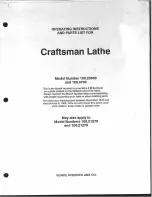
20
PM-236 v4 -207.indd
THREAD CUTTING (METRIC THREADS)
Practically all metric thread pitches from 0.4 mm to .75
mm are cut with one external gear setup: 24T upper,
48T lower. For thread pitches from .6 mm to 7 mm, the
inverse setup is used: 48T upper, 24T lower.
For metric thread cutting the split-nut on the apron must
be left
engaged throughout the entire process
. This
not the case for U.S. standard TPI threads, for which the
normal procedure is to disengage the half-nut after each
pass, reverse the carriage, then re-engage at a specific
indication on the threading dial (see above).
GEARS:
UPPER 24T
LOWER 48T
METRIC THREAD PITCHES (mm)
Speed
MI
0.4
0.45
0.5
0.6
0.7
0.75
MII
0.8
0.9
1
1.2
1.25
1.4
1.5
1.75
Gearbox
B4
C4
C3
C2
A4
D2
E4
A2
E2
GEARS:
UPPER 48T
LOWER 24T
METRIC THREAD PITCHES (mm)
Speed
MI
1.6
1.8
2
2.25
2.4
2.5
2.8
3
3.5
MII
3.2
3.6
4
4.5
4.8
5
5.6
6
7
Gearbox
B4
C4
C3
C2
A4
D2
E4
A2
E2
Figure 3-24
Table of metric pitches vs. gearbox settings
For all metric threads
the top gear drives
the 127T gear. The
lower gear is driven
by the 120T gear.
Figure 3-23
Metric setup
GAP BED
A 9 inch long section of the bed at the headstock end
can be removed to allow turning of diameters up to 7-
/2 in., Figure 3-25.
Figure 3-25
Gap insert
To remove the gap insert back out the arrowed "pusher"
screw two or three turns, then remove the four large
socket head screws securing the insert to the bed. To
minimize cosmetic damage, cut through the paint and
filler along the joint between insert and bed using a
sharp knife or pointed scraper.
Using a 4 mm wrench jack out the two locating pins,
arrowed in Figure 3-26, then tap the insert free with a
Figure 3-26
Gap insert hardware
soft-face mallet.
Before re-installing the insert, be certain that all mating
surfaces are scrupulously clean. Set the insert in place,
lightly tap in the two locating pins, then install the four
large bolts (snug, but not fully tightened). Jack the insert
to the right with the pusher screw to close the gap, if any,
between the ground surfaces of the bed ways at the join
(a visible parting line is acceptable, but a discontinuity
that snags the carriage is not). If a satisfactory join can-
not be achieved, it may be necessary to remove and
reinstall the insert from scratch.




































